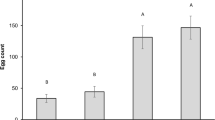Abstract
The mass fractal dimension (MFD) of colonies of mildew (Erysiphe graminis f.sp. hordei) growing on barley was calculated as a measure of their spatial structure. Despite the elongated shape of the colonies imposed by the leaf cellular structure, the MFD remained constant with scale. The mildew MFD differed on different cultivars of barley, and was greater on leaves produced under higher nutrient level indicating a physiological component. Lower MFD values correspond with the thin spreading growth associated with exploration strategies and higher values correspond to the denser, more branched structure associated with exploitation of the substrate. Cultivars showing exploration strategies induced by resistance expression responded to increased nutrient levels more than those expressing little resistance such as Golden Promise.
Similar content being viewed by others
References
Crawford JW, Ritz K and Young IM (1993) Quantification of fungal morphology, gaseous transport and microbial dynamics in soil: an integrated framework utilizing fractal geometry. Geoderma 56: 157–172
Dowson CG, Springham P, Rayner ADM and Boddy L (1989) Resource relationships of foraging mycelial systems of Phanerochaete velutina and Hypholoma fasciculare in soil. New Phytologist 111: 501–509
Jenson B and Munk L (1997) Nitrogen-induced changes in colony density and spore production of Erysiphe graminis f. sp. hordei on seedlings of six spring barley cultivars. Plant Pathology 46: 191–202
Little R and Doodson JK (1972) The reaction of spring barley cultivars to mildew, their disease resistance rating and an interim report on their yield response to mildew control. Journal of the Natational Institute of Agricultural Botany 12: 447–448
Newton AC (1989) Genetic adaptation of Erysiphe graminis f. sp. hordei to barley with partial resistance. Journal of Phytopathology 126: 133–148
Newton AC and Hackett CA (1994) Subjective components of mildew assessment on spring barley. European Journal of Plant Pathology 100: 395–412
Newton AC and McGurk L (1991) Recurrent selection for adaptation to partial resistance in barley by Erysiphe graminis f. sp. hordei. Journal of Phytopathology 132: 328–338
Newton AC and Thomas WTB (1994) Detection of tolerance of barley cultivars to infection by powdery mildew (Erysiphe graminis f. sp. hordei). Euphytica 75: 179–187
Newton AC, Thomas WTB, Guy DC and Gaunt R (1997) The interaction of fertiliser treatment with tolerance to mildew in spring barley. Field Crops Research 55: 45–56
Ritz K and Crawford J (1990) Quantification of the fractal nature of colonies of Trichoderma viride. Mycological Research 94: 1138–1141
Rowe J and Doodson JK (1976) Journal of the National Institute of Agricultural Botany 14: 19–28
Author information
Authors and Affiliations
Rights and permissions
About this article
Cite this article
Newton, A.C., Guy, D.C. Exploration and Exploitation Strategies of Powdery Mildew on Barley Cultivars with Different Levels of Nutrients. European Journal of Plant Pathology 104, 829–833 (1998). https://doi.org/10.1023/A:1008614621523
Issue Date:
DOI: https://doi.org/10.1023/A:1008614621523




